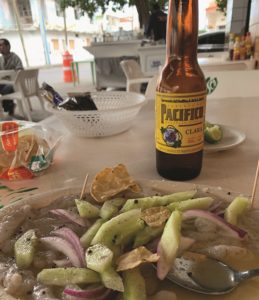Apparently, shrimp is Mazatlán’s superpower. I have been hearing about the glories of the seafood of Sinaloa, particularly its shrimp, for months from Wellfleet neighbors who spend time on Mexico’s Pacific coast each winter. As I turned over yet another shovel of snow to free the back door from one of winter’s last assaults, all I could think about was the digital boarding pass on my phone and the promise of long sunny days and plates piled high with shrimp.
Twenty-four hours later, my N95 mask and shoes cast aside, I park myself on my friend Jim’s balcony overlooking the Gulf of California. Although I can’t see it from here, the Baja peninsula is in the distance. And between here and there are waters teeming with shrimp.
Born in Louisiana, I was raised on shrimp po’ boys and étoufée. My feelings wavered when, early in my love affair with the Outer Cape, I learned that I would see no roadside pickup trucks offering ice chests full of freshly harvested shrimp for sale here. Perhaps, I tell myself, before the climate apocalypse, the warming waters will usher in streams of Southern shrimp looking for new digs. That way, my last meal before the world goes dark can be fried shrimp.

The day is a little overcast, which will provide some relief from the sun as I begin my Mazatlán walkabout. I walk along the malecón, the promenade that joins the town to the sea. People are lounging on the sand below. Up ahead, at a once-red cart under a tattered umbrella, a man shucks oysters. I make a mental note of his location as I’ll need to compare Mazatlán oysters to Wellfleets.
But as the sun rises to midday, it’s shrimp I’m in search of. I turn north, toward the old town, and one block off the malecón I spot a small neighborhood restaurant on the corner. In front, laid out on beds of ice, are oysters, clear-eyed fish, and glistening shrimp, heads still on. A rough sign proclaims “aguachiles” and I know this is the spot for my first meal.
Aguachile is a Sinaloan dish found all along the coast. Like its siblings, ceviche and crudo, it features sliced seafood marinated in lime juice and spiked with the local chile known as chiltepín. Unlike ceviche, traditional aguachile is served immediately after mixing the seafood with the citrus, rather than allowing the seafood to “cook” in the juices.
I step under the awning of Mariscos Toño and the waiter motions me to a table. I order a locally bottled Pacífico beer and a large aguachile de camarón. Local families occupy adjacent tables and I wish my Spanish was good enough to eavesdrop. A slight breeze ruffles the stack of paper napkins that sit under a paperweight on my table. A sliver of the blue bay sparkles in the distance.
The waiter returns with a platter of gorgeous raw shrimp. Sliced in half lengthwise and just turning opaque from their fresh lime marinade, they are daubed with a green chili salsa. Sliced cucumbers, slivered red onions, and cilantro are scattered generously on top.
The tang of the lime and the heat of the chiltepín accentuate the clean flavor of the shrimp. I scoop up bites with the oddly delicious tostadas that appeared in a bag, nonchalantly, alongside my plate.
“Todo bien?” the waiter asks. “Yes,” I say, everything truly is good. I resolve to add aguachile made with fresh Cape Cod scallops to my repertoire. Then I hold up my beer bottle and say, “Uno más, por favor.”
Toño’s Shrimp or Scallop Aguachile
Serves 4-6 as a snack or appetizer
1 lb. medium shrimp or scallops, the freshest available
Kosher salt
1 Tbsp. chiltepín or 2 serrano chiles, stemmed and minced
1 garlic clove, roughly chopped
1 tsp. Mexican oregano|
2 Tbsp. water
½ cup fresh lime juice
Freshly ground black pepper
¼ cup thinly sliced red onion
¼ cup sliced seeded cucumber
1 handful of cilantro, roughly chopped
Tostadas and sliced avocado, for serving
Peel the shrimp, slicing them in half lengthwise and discarding the vein. If using scallops, slice them into quarter-inch-thick disks.
Transfer the seafood to a plate, salt generously, cover, and refrigerate at least one hour and up to two.
Meanwhile, with a mortar and pestle, crush the garlic with a big pinch of kosher salt, until it forms a paste. Add the chiles and the oregano and continue grinding until the chiles are pulverized. Scrape into a large bowl and add the water and lime juice and a few grinds of pepper. (Alternatively, you can whirl the garlic, chilies, and oregano with the water and lime juice in a blender.)
Toss shrimp or scallops with the chile-lime marinade, top with the onion, cucumber slices, and cilantro. Taste and season once more with salt and pepper and serve right away with tostadas and avocado.



